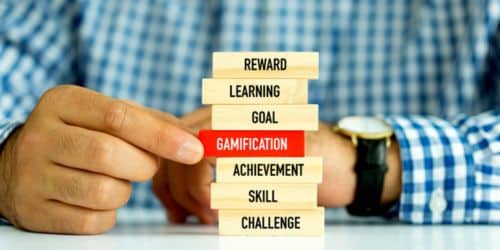Anyone who has or was a procrastinating child is familiar with the expression “I’ll time you.”Parents say that to their kids to make tasks appear more of a game and less of a task— in other words, more fun—because they know their youngsters would rather prefer PlayStation than clean their rooms or fold laundry. The ticking clock adds a touch of fun to a boring chore. And children enjoy playing. Everybody does it. It’s only natural.
That’s a simple summary of gamification: when you apply game principles (such as a timer, points, badges, and leaderboards) to ordinary situations in order to push someone to achieve something.
What Is Gamification?
Gamification is all about making non-game activities feel like they are games. It’s an approach to increase involvement and productivity by incorporating extrinsic motivation—basically, dangling rewards like carrots on sticks.
Despite being coined in 2002, the notion stretches back to the era of the twentieth century, when retail establishments implemented reward systems to strengthen consumer loyalty and industrial managers pushed factory workers to consider themselves competitors.
Overview
Gamification thrived during the digital explosion in the 2000s. An entire industry of gamification consulting firms and SaaS companies have cropped up to assist organizations in adding points, badges, and leaderboards to their software.
Although it has been around for more than a decade, the term “Gamification” is still relatively new and is used fairly ambiguously. You’re presumably here to figure out what gamification is and what it can accomplish for you. This article will cast a little light on the topic and clarify the term “gamification.”
Nonetheless, The use of gamification isn’t only for encouraging children to accomplish household tasks. Companies of various niches gamify their products, making them “sticky” to increase customer engagement, from Tik Tok to Twitter, Starbucks to SAP.
How Does Gamification Work?
In order to make gamification effective, it has to trigger human emotions that are linked to a positive user experience. In other words, a positive user experience is necessary for gamification to work. Gamification has various different mechanics and dynamics that can be utilized in conjunction to generate certain behaviors. Each gamification solution is built on these game principles. Points, badges, and leaderboards are common game mechanics.
What exactly are these game mechanics?
There are numerous game mechanics that tap into a user’s psychology and chart the user’s experience based on the types as well as the intensity of emotions felt at the moment.
What are the points?
Typically, points are awarded for successfully completing a challenge or certain activities. These points can be used to gauge a player’s progress. Points’ principal function is to provide feedback. A player’s performance can be evaluated based on the number of points awarded for a specific action or achievement.
What are badges?
The player receives an indication or iconic badge for meeting all conditions for a certain achievement. Badges serve two primary purposes. Before anything else, it serves as a goal toward which a player can strive. After achieving this goal and earning the associated badge, it acts as a virtual status symbol as well as a visual depiction of mastery. This also indicates that the player in question has achieved a feat of the associated difficulty.
What are leaderboards?
Leaderboards rank players according to their performance. The higher the rank, the higher the worth. They are a graphical way of judging who the top performer is. This factor is a powerful motivator to outperform and, consequently, outrank your opponents. It gives you virtual status (everyone wants to get to the top, right?). Think of it as healthy competition that keeps players competing to prove they’re better, or rather, the best.
Game dynamics and game mechanics make up gamification. Scores, awards, stages, scoreboards, and challenges are game mechanics. However, game dynamics are determined by active feedback, clear goals and laws, an intriguing plot, and reasonable barriers. When these parts work together, the brain of the person produces dopamine. We keep playing because dopamine makes us joyful.
Basically, numerous sectors employ gamification strategies to incentivize and delight employees and boost company and operational efficiency. Gamification in education and communication is the same. The key unlocks the targeted target’s interest.
Almost all studies show that gamification works and has a favorable impact. It is motivating and improves user delight, but it can be detrimental if the competition becomes too fierce.
What Is Gamification In Various Sectors?
Gamification, as we now know, is the employment of game-development components and game concepts in non-game contexts. Also, we are aware of the many methods of actualization (businesses, education, chores, marketing, apps, etc.) But one may have questions like “How is it implemented?”, “What is the relationship between gamification and education?” or “How is it implored in these sectors?”
What is Gamification in Education?
For a variety of reasons, gamification is becoming more popular in educational settings. In a nutshell, it makes the hard stuff more fun,’ thereby motivating learners and increasing their engagement with the topic at hand.
According to the gamification hypothesis in education, learners learn best when they are also having fun. Not only that, but kids grasp the subject matter best when they have objectives, milestones, and accomplishments to strive for, all while remaining enjoyable to the learner. In simple terms, they learn best by seeing learning the same way they see games, but in an educational way.
Because video games include addictive qualities that entice and hook youngsters (as well as grownups), it is purely natural that we observe similar engagement results when these game-based components are applied to learning methods.
Gamification in education uses game-based elements including point scoring, peer competition, teamwork, and score tables to boost involvement and commitment, help students assimilate new content, and measure their understanding. The fact that gamification is useful in formal education settings, as well as self-paced learning environments, demonstrates that its effects persist into later life.
Gamification In Business
Employees are more likely to do their jobs well when gamification is used. Gamification can motivate people to perform a variety of tasks in different settings. Gaming can increase office morale and productivity. Humans require competition. Adding an element of competition to your product, workplace, or service just strengthens our rudimentary and primordial attachment to it.
Game mechanics simplify the duties of an employee by making goals obvious and simple to comprehend. An employee can see progress in how they perform, receive instant feedback on achievements, and also interact with peers through cooperation and rivalry.
Businesses frequently use gamification to improve employee learning, recruitment, performance evaluation, and overall workplace efficiency.
Among our top seven gamification examples are Ferrero, Unibet, KFC, Under Armour, M&Ms, Starbucks, Nike, and Duolingo. Each of the seven examples demonstrates how gamification can raise the bar for loyalty schemes, activity, learning, and commerce.
What Is Gamification In Marketing?
Gamification in regards to marketing is a really successful approach for firms to creatively convey a message. It is applicable to an extensive variety of enterprises across all industries. There are two approaches to gamification: using games that revolve around chance, or gamifying specific components of the user’s experience.
Points, levels, virtual currency, leaderboards, countdowns, progress boards, or badges based on game mechanics are gamification components that users get as rewards for certain efforts. It’s a tool that can keep existing for people of all ages and may provide both current and prospective customers with hours of pleasure and fun. The people who play a game have a chance to win something. In exchange, your company or business will benefit from more marketing.
Gamification brings many benefits to both the consumer experience and business productivity if implemented sequentially. The following are a few examples with brief explanations:
#1. Increase and improve user engagement:
Because gamification encourages users to execute specific actions, engagement rates are frequently higher and better than in past campaigns. Engagement can be the first step in establishing a long-term relationship between a customer and a business or brand, which leads to the next advantage of gamified campaigns.
#2. Increases brand awareness and loyalty:
As previously stated, consumers who remember your brand’s name after having an enjoyable experience with a branded game are a significant asset to your business. For starters, individuals may become emotionally tied to your brand, but if that happens, they are more inclined to become loyal customers than neutral or actively disengaged ones.
According to a recent Gallup report, engaged consumers “represent an average 23% premium when it comes to sharing of wallet, profitability, revenue, and relationship building when compared to the average customer.” This is particularly accurate for retail banking, consumer electronics, restaurant, hospitality, and insurance enterprises, as reported by the same journal.
#3. Aids in the collection of important client data:
Gamification enables you to obtain user data in accordance with GDPR (General Data Protection Regulation) and CCPA (California Consumer Privacy Act) rules. Customers also tend to be more likely to disclose data while they are participating in a game.
#4. Customers are educated about your products or services:
Gamification marketing may be a fun and easy technique to educate users about the primary benefits of your product or service.
What Are The Five Basic Elements Of Gamification?
The Five basic elements of gamification refer to psychological principles driven purely by human emotions. These are categorized into:
- Challenge and Mastery
- Feedback and Progression
- Social Interaction and Competition
- Rewards and Incentives
- Narrative and Immersion
What Is An Example Of Gamification In Learning?
One way to use gamification in learning is to divide a class into equal groups of students, give each group a project, and grade them on how well they did their study and the new knowledge they acquire. And the students should know beforehand that the score of each group will determine the quality of their rewards. All within a set time frame.
In this way, one is combining game mechanics such as teamwork, scoreboards, timers, rewards, and a pinch of competitiveness with education. Students are now eager to learn as they look forward to rewards as well as what to brag about to other classmates. And let’s not forget the one thing a child consciously and unconsciously craves competition. In simple terms, learning becomes fun.
What’s Another Word For Gamification?
The term “Gamification” is somewhat new. There are a few synonyms, and each one covers an emerging aspect of gamification, and hints at a potential shift away from the term itself. Some of them are:
- Engagement
- Game Learning
- Applied Game Design, and a bunch of others.
Gamification Benefits
Tourism and arts and entertainment games are effective at touching consumers’ hearts. Gamification benefits include experience, identity, engagement, and involvement. The learning pyramid shows how reading, hearing, and doing compare to learning. The game involves participation and is more likely to produce positive results than typical education and communication techniques.
See Also GAMES AS A SERVICE: Meaning, Examples, Model & Companies
Final Thoughts
New generations require new ways of interacting. Gamification and game technology are essential for sharing our cultural heritage in this technological age. Academics have explored how the gaming sector allows us to reach people worldwide and offers new options to improve visitors’ and users’ experiences.
Children play on their own, while we often argue that adults need an excuse to play. Gamification in education and other areas of society should make future generations enthusiastic to play. We no longer grow out of playing; instead, the games grow with us. As a result, it is critical to employ games for social interaction.
What is Gamification FAQs
What Is An Example Of A Gamification Tool?
An example of a gamification tool is Arcademics.
What Are The Four Elements Of Gamification?
The four elements of gamification are:
- Progress
- Productivity
- Variety
- Play (Fun)
What Are The Three Categories Of Gamification?
- Points and leaderboard
- Points, Badges, and Rewards
- Gamification Ownership
What Are The Two Types Of Gamification?
Structural (Game mechanics) and Content (Game dynamics)






